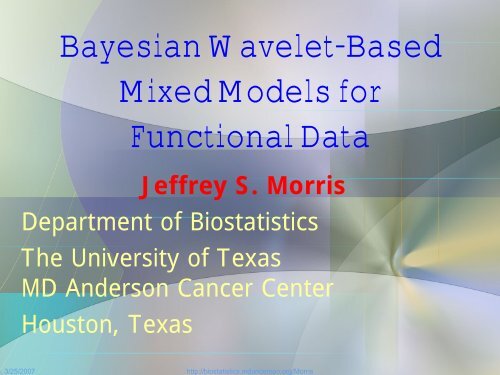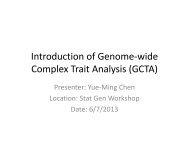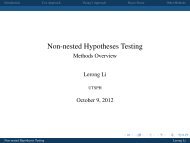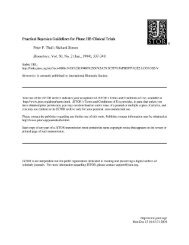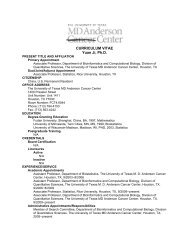Wavelet-Based Functional Mixed Models
Wavelet-Based Functional Mixed Models
Wavelet-Based Functional Mixed Models
- No tags were found...
You also want an ePaper? Increase the reach of your titles
YUMPU automatically turns print PDFs into web optimized ePapers that Google loves.
3/25/2007 http://biostatistics.mdanderson.org/MorrisBayesian <strong>Wavelet</strong>-<strong>Based</strong><strong>Mixed</strong> <strong>Models</strong> for<strong>Functional</strong> DataJeffrey S. MorrisDepartment of BiostatisticsThe University of TexasMD Anderson Cancer CenterHouston, Texas
3/25/2007• <strong>Functional</strong> Data:<strong>Functional</strong> Data– Ideal units of observation: curves– Observed data: curves sampled on fine grid• Increasingly encountered in practice with new technologiestaking automated measurements
3/25/2007<strong>Functional</strong> Data• <strong>Functional</strong> Data:– Ideal units of observation: curves– Observed data: curves sampled on fine grid• Increasingly encountered in practice with new technologiestaking automated measurements• Challenge of <strong>Functional</strong> Data Analysis (Ramsayand Silverman 1997): Must simultaneously considerregularization and replication– Regularization: take advantage of functional structureto borrow strength from adjacent observations withincurve– Replication: combining information across sample curvesto make inferences on population from which they came
3/25/2007Example: Colon CarcinogenesisLumen• Stem Cells:Mother cellsnear crypt base• Depth in crypt ~age of cells• Relative CellPosition: depthwithin cryptst ∈ (0,1)crypts
3/25/2007Colon Carcinogenesis Data• 30 rats fed 1 of 2 diets, exposed to carcinogen, euthanized after 1 of 5times after carcinogen exposure (0h,3h,6h,9h,12h)• MGMT measured via IHCS for 15 crypts/rat, ~250 obs/crypt• Diet effect? Vary by time and/or crypt depth? Related to other covariates(DNA adduct/apoptosis)? Relative variability from rat-to-rat vs. crypt-tocrypt?
3/25/2007Example: Mass Spectrometry Proteomics• Central dogma: DNA mRNA protein• Microarrays: measure expression levels of10,000s of genes in sample (amount of mRNA)• Proteomics: look at proteins in sample.– Gaining increased attention in research• Proteins more biologically relevant than mRNA• Can use readily available fluids (e.g. blood, urine)• MALDI-TOF: mass spectrometry instrumentthat can see 100s or 1000s of proteins insample
3/25/2007Sample MALDI-TOF Spectrum• MALDI-TOF Spectrum: observed function• g(t) = intensity of spectrum at m/z value t• Intensity at peak (roughly) estimates the abundance ofsome protein with molecular weight of t Daltons
3/25/2007Example: MALDI• 16 mice had 1 of 2 cancer cell lines injected into 1 of2 organs (lung or brain)• Cell lines:– A375P: human melanoma, low metastatic potential– PC3MM2: human prostate, highly metastatic• Blood serum extracted and placed on SELDI chip• Run at 2 different laser intensities (low/ high)• Total of 32 spectra (observed functions), 2 permouse• Observations on equally-spaced grid of 7985
3/25/2007Example: MALDI• Goal: Find proteins differentially expressed by:– Host organ site (lung/brain)– Donor cell line (A375P/PC3MM2)– Organ-by-cell line interaction• Combine information across laserintensities: Requires us to include in modeling:– <strong>Functional</strong> laser intensity effect– Random effect functions to account forcorrelation between spectra from same mouse
3/25/2007Example: Accelerometer Data• Accelerometers: small motion sensors thatdigitally record minute-by-minute activity levels– Increasingly used in surveillance and interventionstudies• TriTrac-R3D: sensor worn on hip– Minute-by-minute record of motion in 3 axes– Condensed into single activity levelmeasurement/minute– Activity “profile” for each day
3/25/2007Accelerometer Data
3/25/2007Accelerometer Data• Planet Health Study (Harvard University):– Intervention study investigating activity levels of middleschool children in Boston area schools– Children’s activity levels objectively monitored usingTriTrac-R3D activity monitor for one or two 4-daysessions– Data considered: 292 daily profiles/103 children/5schools, 660 measurements/profile (every minute from9am-8pm)• Primary Goal: Assess how activity levels vary acrosschild-level and other covariates, and assess whether theseeffects vary by time-of-day.
3/25/2007Heatmap of Missingness(Black=missing)
3/25/2007<strong>Functional</strong> DataCommon characteristics of these data:• Extremely high dimensional data(dozens to 100’s of curves, 100’s to 1000’s obs/curve)• Complex, irregular, spatially heterogeneous functionswith many local features: requires adaptive methodsincorporating nonparametric representation of curves• <strong>Functional</strong> response, relate to scalar covariates• Functions not i.i.d. – need to model correlationstructure between curves• Want to perform inference, not just estimation.
3/25/2007Linear <strong>Mixed</strong> <strong>Models</strong>Linear <strong>Mixed</strong> Model (Laird and Ware, 1982):Y{ = { Xp×1}β +Z{}×ue{N × 1 N × p N × m N × 1m1+ue~~NN((0 ,0 ,mN}×Dm){ R )• Fixed effects part, Xβ, accommodate a broadclass of mean structures, including maineffects, interactions, and linear coefficients.• Random effects part, Zu, provides aconvenient mechanism for modelingcorrelation among the N observations.×N
3/25/2007<strong>Functional</strong> <strong>Mixed</strong> Model (FMM)Suppose we observe a sample of N curves,Y i (t), i=1, …, N, on a closed interval TNN×p}N}× mY{( t)= X{B(t)+ Z U{( t)+{E(t)functionsp functionsm functionsNfunctions
3/25/2007<strong>Functional</strong> <strong>Mixed</strong> Model (FMM)Suppose we observe a sample of N curves,Y i (t), i=1, …, N, on a closed interval TNN×p}N}× mY{( t)= X{B(t)+ Z U{( t)+{E(t)functionsp functionsm functions• DEFN: U(t)~MGP(P,Q) implies the rows of P -1/2 U(t) are ind.mean zero Gaussian Processes with covariance surface Q(t 1 ,t 2 ).– <strong>Functional</strong> generalization of Matrix Normal (Dawid, 1981).– Implies Cov{U i (t 1 ),U j (t 2 )}=P ij * Q(t 1 ,t 2 )Nfunctions
3/25/2007<strong>Functional</strong> <strong>Mixed</strong> Model (FMM)Suppose we observe a sample of N curves,Y i (t), i=1, …, N, on a closed interval TNN×p}N}× mY{( t)= X{B(t)+ Z U{( t)+{E(t)functionsp functionsm functionsNfunctionsU ( t)~E(t)~MGP(P,Q)MGP(R,S)• DEFN: U(t)~MGP(P,Q) implies the rows of P -1/2 U(t) are ind.mean zero Gaussian Processes with covariance surface Q(t 1 ,t 2 ).– <strong>Functional</strong> generalization of Matrix Normal (Dawid, 1981).– Implies Cov{U i (t 1 ),U j (t 2 )}=P ij * Q(t 1 ,t 2 )
3/25/2007<strong>Functional</strong> <strong>Mixed</strong> Model (FMM)Suppose we observe a sample of N curves,Y i (t), i=1, …, N, on a closed interval TNN×p}N}× mY{( t)= X{B(t)+ Z U{( t)+{E(t)functionsp functionsm functionsNfunctionsU ( t)~E(t)~MGP(P,Q)MGP(R,S)• DEFN: U(t)~MGP(P,Q) implies the rows of P -1/2 U(t) are ind.mean zero Gaussian Processes with covariance surface Q(t 1 ,t 2 ).– <strong>Functional</strong> generalization of Matrix Normal (Dawid, 1981).– Implies Cov{U i (t 1 ),U j (t 2 )}=P ij * Q(t 1 ,t 2 )• P and R are covariance matrices (between-curve)• Q(t 1 ,t 2 ) and S(t 1 ,t 2 ) are covariance surfaces on T ×T
3/25/2007Model: MALDI ExampleLet Y i (t) be the MALDI spectrum ilog4162 i= ∑ ∑0ij jik k+itj=1k=1{ Y ( t)} B ( t)+ X B ( t)+ Z U ( t)E ( )• X i1 =1 for lung, -1 brain. X i2 =1 for A375P, -1 for PC3MM2X i3 = X 1 * X 2X i4 =1 for low laser intensity, -1 high.• B 0 (t) = overall mean spectrum B 1 (t) = organ main effect functionB 2 (t) = cell-line main effectB 4 (t) = laser intensity effect functionB 3 (t) = org x cell-line int function• Z ik =1 if spectrum i is from mouse k (k=1, …, 16)• U k (t) is random effect function for mouse k.
3/25/2007Discrete Version of FMMSuppose each observed curve is sampled on acommon equally-spaced grid of length T.N × p}N}× mU ~ MN ( P,QY { = X { B + Z U{ + { E E ~ MN ( R,S)N × T p × T m × T N × T• U and E follow the Matrix Normal distn.– U~MN(P,Q) implies Cov{U ij , U i’j’ }=P ii’ *Q jj’• P and R are covariance matrices (m × m & N × N)• Q and S are within-curve covariance matrices (T × T))
3/25/2007<strong>Functional</strong> <strong>Mixed</strong> <strong>Models</strong>• Key feature of FMM: Does not require specificationof parametric form for curves• Basis function approach: y(t)=Σd jk ψ jk (t)
3/25/2007<strong>Functional</strong> <strong>Mixed</strong> <strong>Models</strong>• Key feature of FMM: Does not require specificationof parametric form for curves• Basis function approach: y(t)=Σd jk ψ jk (t)• Benefits of Using <strong>Wavelet</strong> Bases1. Compact support allows efficient representations oflocal features2. Whitening property allows parsimonious yet flexiblerepresentations of Q and S3. Decomposes function in both frequency and timedomains– Enables mechanism for adaptive regularization of functions4. Orthonormal transformation has linearrepresentation, and special structure allows fastcalculation of coefficients.
3/25/2007<strong>Wavelet</strong>-<strong>Based</strong> FMM:General Approach1. Project observed functions Y into waveletspace.2. Fit FMM in wavelet space.(Use MCMC to get posterior samples)3. Project wavelet-space estimates(posterior samples) back to data space.
3/25/2007<strong>Wavelet</strong>-<strong>Based</strong> FMM:General Approach1. Project observed functions Yinto wavelet space.2. Fit FMM in wavelet space(Use MCMC to get posterior samples)3. Project wavelet-space estimates (posteriorsamples) back to data space.
3/25/2007<strong>Wavelet</strong> Space Representation∑y( t)= d ψ ( t)jkψj,k∈Ijk( t)=2jk− j / 2ψ (2d− j / 2t∫= y( t)ψ ( t)dtjk jk− k)
3/25/2007<strong>Wavelet</strong> Space Representation∑y( t)= d ψ ( t)jkψj,k∈IjkLinearRepresentation:( t)1=×}y2jk− j / 2ψ (2= d{WdT T }× T1×T− j / 2t∫= y( t)ψ ( t)dtjk jk− k)DWT Design Matrix W=[ψ 11 (t) ψ 12 (t) ... ψ JK (t)]
3/25/2007<strong>Wavelet</strong> Space Representation∑y( t)= d ψ ( t)jkψj,k∈IjkLinearRepresentation:( t)1=×}y2jk− j / 2ψ (2= d{WdT T }× T1×T− j / 2t∫= y( t)ψ ( t)dtjk jk− k)×}dT T }× T= y{W '1 × TDWT Design Matrix W=[ψ 11 (t) ψ 12 (t) ... ψ JK (t)]1
3/25/2007<strong>Wavelet</strong> Space Representation∑y( t)= d ψ ( t)jkψj,k∈IjkLinearRepresentation:( t)1=×}y2jk− j / 2ψ (2= d{WdT T }× T1×T− j / 2t∫= y( t)ψ ( t)dtjk jk− k)×}dT T }× T= y{W '1 × TDWT Design Matrix W=[ψ 11 (t) ψ 12 (t) ... ψ JK (t)]Given T-vector y consisting of function sampled on equallyspacedgrid, a pyramid-based algorithm for DWT (Mallat)can be used to obtain d, T –vector of wavelet coefficients,in O(T) operations (converse also true)1
3/25/2007<strong>Wavelet</strong>-<strong>Based</strong> FMM1. Project observed functions Y to waveletspace• Apply DWT to rows of Y to get wavelet coefficientscorresponding to each observed function{ D = Y{ W{'N×TN×TT×T• Projects the observed curves into the spacespanned by the wavelet bases.
3/25/2007<strong>Wavelet</strong>-<strong>Based</strong> FMM:General Approach1. Project observed functions Y intowavelet space.2. Fit FMM in wavelet space(Use MCMC to get posteriorsamples)3. Project wavelet-space estimates(posterior samples) back to data space.
3/25/2007<strong>Wavelet</strong> Space FMMY{=×}XNp{ B+N}×ZmU{ + { EN × T p×Tm × T N × T
3/25/2007<strong>Wavelet</strong> Space FMMY{=×}XNp{ B+N}×ZmU{ + { EN × T p×Tm × T N × T<strong>Wavelet</strong> RepresentationsY=DWB=B*WU=U*WE=E*W
3/25/2007<strong>Wavelet</strong> Space FMM{ DW=×}XNp*B{W+N}×Zm*U123W+*123 E WN × T p×Tm × T N × T<strong>Wavelet</strong> RepresentationsY=DWB=B*WU=U*WE=E*W
3/25/2007<strong>Wavelet</strong> Space FMM{ DW WN × T'=×}XNp*B{W Wp×T' +N}×Zm*U123W Wm × T' +*123 E W WN × T'<strong>Wavelet</strong> RepresentationsY=DWB=B*WU=U*WE=E*WWW’=I
3/25/2007<strong>Wavelet</strong> Space FMM{ D=×}XNp*{ B+N}×Zm* *U{ + { EN × T p×Tm × T N × T<strong>Wavelet</strong> RepresentationsYW’=DBW’=B*UW’=U*EW’=E*WW’=I
3/25/2007<strong>Wavelet</strong> Space FMMD : empirical wavelet coefficients for observed curvesRow i contains wavelet coefficients for observed curve iEach column double-indexed by wavelet scale j and location k{ D=×}XNp*{ B+N}×Zm* *U{ + { EN × T p × T m × T N × T• B*=BW’ & U*=UW’: Rows contain wavelet coefficients forthe fixed and random effect functions, respectively• E*=EW’ is the matrix of wavelet-space residuals
3/25/2007<strong>Wavelet</strong> Space FMMD : empirical wavelet coefficients for observed curvesRow i contains wavelet coefficients for observed curve iEach column double-indexed by wavelet scale j and location k{ D=×}XNp*{ B+N}×Zm* *U{ + { EN × T p × T m × T N × TMN(P,QMN(R,S• B*=BW’ & U*=UW’: Rows contain wavelet coefficients forthe fixed and random effect functions, respectively• E*=EW’ is the matrix of wavelet-space residualsUE**~~*))*
3/25/2007<strong>Wavelet</strong> Space FMMD : empirical wavelet coefficients for observed curvesRow i contains wavelet coefficients for observed curve iEach column double-indexed by wavelet scale j and location k{ D=×}XNp*{ B+N}×Zm* *U{ + { EN × T p × T m × T N × TMN(P,QMN(R,S• B*=BW’ & U*=UW’: Rows contain wavelet coefficients forthe fixed and random effect functions, respectively• E*=EW’ is the matrix of wavelet-space residuals• Q*=WQW’ and S*=WSW’ model the covariance structurebetween wavelet coefficients for a given function.• P, Q*, R and S* are typically too large to estimate in anunstructured fashion.UE**~~*))*
3/25/2007Covariance Assumptions• We choose parametric structures for P and R tomodel the covariance structure between the curves.– <strong>Based</strong> on the experimental design– As in linear mixed models.• We assume the between-wavelet covariance matricesQ* and S* are diagonal (Q*=diag{q jk },S*=diag{s jk }).– <strong>Wavelet</strong> coefficients within given function modeled as independent– Heuristically justified by whitening property of DWT– Common working assumption in wavelet regression settings– Is parsimonious in wavelet space (T parameters), yet leads to flexibleclass of nonstationary covariance structures in data space– Key: We allow variances to vary by scale j and location k
3/25/2007Simulation: Covariance Structure• True mean: line plus peak• True variance: increasing in t, with extra var at peak• True autocorrelation: Strong autocorrelation (0.9) at left,weak autocorrelation (0.1) right, extra at peak
3/25/2007Simulation: Covariance Structure• Independence in wavelet space accommodates varyingdegrees of autocorrelation in data space• Allowing variance components to vary across scale j andlocation k accommodates nonstationarities
3/25/2007Simulation: Covariance Structure• Most wavelet regression methods (Fan and Lin 1998, Morris, et al.2003, Abramovich and Angelini 2006, Antoniadis and Sapatinas 2006)only index variances by scale j, but not location k.• Not flexible enough to capture nonstat. covariance features• Unnecessary restriction in multiple function case, since replicatefunctions allow estimation of separate VC for each (j,k)
3/25/2007Model Each Column Separately{}{}{ {1*1*1*1 ××××××++=NjkmjkmNpjkpNNjkeuZBXd)(0,~)(0,~****jkjkjkjksRNeqPNu⋅⋅
3/25/2007Prior AssumptionsMixture prior on B ijk * :B*ijk=γ*ijkN*ijk( 0, τ ) + (1 −γ) δij0Bernoulli(*πijk ijγ =)• Nonlinearly shrinks B ijk*towards 0, leading toadaptively regularized estimates of B i (t).• τ ij & π ij are regularization parameters• They can be elicited, or estimated from the data usingempirical Bayes approach (extending Clyde & George1999 to FMM)
3/25/2007Adaptive Regularization
3/25/2007Adaptive Regularization
3/25/2007Adaptive Regularization
3/25/2007Model Fitting• MCMC to obtain posterior samples of model quantities– Work with marginal likelihood; U* integ. out;• Let Ω be a vector containing ALL covarianceparameters (i.e. P,R,Q*,S*).MCMC Steps1. Sample from f(B*|D,Ω):Mixture of normals and point masses at 0 for each i,j,k.2. Sample from f(Ω|D,B*):Metropolis-Hastings steps for each j,k3. If desired, sample from f(U*|D,B*,Ω):Multivariate normals
3/25/2007<strong>Wavelet</strong>-<strong>Based</strong> FMM:General Approach1. Project observed functions Y intowavelet space.2. Fit FMM in wavelet space(Use MCMC to get posterior samples)3. Project wavelet-space estimates(posterior samples) back to dataspace.
3/25/2007<strong>Wavelet</strong>-<strong>Based</strong> FMM3. Project wavelet-space estimates(posterior samples) back to dataspace.• Apply IDWT to posterior samples of B* toget posterior samples of fixed effectfunctions B j (t) for i=1,…, p, on grid t.B=B*W• Posterior samples of U k (t), Q, and S are alsoavailable, if desired.
3/25/2007Adaptive Regularization• Posterior samples/estimates of fixed effectfunctions B i (t) adaptively regularized as a result ofshrinkage prior applied to wavelet coefficients.1.5(a) School Elog(MET)1• Able to preservedominant spikes inmean curves, ifpresent0.5011am 1pm 3pm 5pm 7pmTim e of Day
3/25/2007Adaptive Regularization
3/25/2007Adaptive Regularization• Posterior samples/estimates of random effect functions U j (t)are also adaptively regularized from Gaussian prior, since eachwavelet coefficient has its own random effect & residualvariance• Able to preservespikes in randomeffect functions,as well•Important forestimation ofrandom effectfunctions AND forvalid inference onfixed effectfunctions.
3/25/2007Adaptive Regularization• While adaptive to irregularity, this framework can alsoyield relatively smooth effect functions when the datasupports smooth representations.
3/25/2007Bayesian InferenceGiven posterior samples of all model quantities, we canperform desired Bayesian inference or prediction:1. Pointwise posterior credible intervals for functional effects2. Posterior probabilities of interest – either pointwise, joint,or aggregating across locations within the curve.3. Can account for multiple testing in identifying significantregions of curves by controlling the expected Bayesian FDR4. Can compute posterior predictive distributions, whichcan be used for model-checking or other purposes.
3/25/2007Bayesian Inference:Identifying Significant Regions of CurvesProcedure (desired effect size ≥δ, FDR α)1. Compute pointwise posterior probabilities of effect size ofinterest being at least δp il =Pr{|B i (t l )|>δ|Y} for l=1, …, T2. Sort in descending order of p il {p i(l) , l=1, …, T}3. Identify cutpoint ϕ α on posterior probabilities that controlsexpected Bayesian FDR to be ≤ α ϕ α =p i(λ) ,wherel*⎡⎤λ = max⎢l*:∑{1− pi ( l)} ≤ l *α ⎥⎣ l=1⎦4. Flag the set of locations {t l : p il ≤ϕ α } as significant(According to model, expect only α to be false pos.)
3/25/2007Bayesian Inference:Identifying Significant Regions of CurvesNotes• This approach takes both statistical and practical significanceinto account when declaring differences significant.• Given choice of cutpoint on posterior probabilities to flagsignificant regions, we can also estimate false negative rate(FNR), sensitivity, and specificity for declaring flagged regionssignificantly different.• This approach can be used for any setting where estimatedposterior probabilities are available for effect sizes (includingbut not limited to functional data setting)
3/25/2007Results: MALDI Example• Using α=0.05, δ=1 (2-fold expression on log 2scale), we flag a number of spectral regions.
3/25/2007Results: MALDI Example• 3900 D (~100-fold) (CGRP-II): dilates blood vessels in brain• 7620 D (~5-fold) (neurogranin): active in synaptic modeling inbrain (Not detected as peak)
3/25/2007Results: SELDI Example• Inclusion of nonparametric functional laser intensity effectis able to adjust for systematic differences in the x and yaxes between laser intensity scans
3/25/2007Results: MALDI Example• Draws of spectra from posterior predictive distributionyield data that looks like real MALDI data (3 rd column),indicating reasonable model fit.
3/25/2007Heatmap of Missingness(Black=missing)
3/25/2007Incomplete Profile
3/25/2007Incomplete Profiles•WFMMcan only be applied to completeprofiles (with no missing regions)–95of the 292 profiles complete from 9am-8pm• How do we incorporate information fromother 197 incomplete profiles ?
3/25/2007Approach: Incomplete Profiles1. First fit model to complete profiles, get posterior distribution samplesfor model parameters.2. Use these to estimate predictive distributions for the the incompleteprofiles
3/25/2007Predictive Distribution}|)(),({),|(},,|)({)(}|)({212CiiiiCiYtYtYCOVtYfZXtYftYYtYE=ΘΘ== ∫())(1iCitdtΣΘμ
3/25/2007Approach: Incomplete Profiles1. First fit model to complete profiles, get posterior distribution samplesfor model parameters.2. Use these to estimate predictive distributions for the the incompleteprofiles• Borrow information about what the curves in these regions look like.• Account for child-specific and day-specific covariates.• Integrates over uncertainty in parameter estimation
3/25/2007Approach: Incomplete Profiles1. First fit model to complete profiles, get posterior distribution samplesfor model parameters.2. Use these to estimate predictive distributions for the the incompleteprofiles• Borrow information about what the curves in these regions look like.• Account for child-specific and day-specific covariates.• Integrates over uncertainty in parameter estimation3. Regress missing data on the observed data to obtain imputationdistribution for missing regions
3/25/2007Predictive Distribution}|)(),({),()|(},,|)({)(}|)({)(2121CiiiCiiCiiYtYtYCOVttYfZXtYftYYtYEt=ΘΘ== ∫ dΣΘμ
3/25/2007μΣM | OiM | OiImputation distribution=μ= ΣMiM , Mi+ Σ− ΣM , Oi( ΣM , OiO,Oi( Σ)O,Oi−1)( Y−1OiΣ− μO,MiOi)
3/25/2007Approach: Incomplete Profiles1. First fit model to complete profiles, get posterior distribution samplesfor model parameters.2. Use these to estimate predictive distributions for the the incompleteprofiles• Borrow information about what the curves in these regions look like.• Account for child-specific and day-specific covariates.• Integrates over uncertainty in parameter estimation3. Regress missing data on the observed data to obtain imputationdistribution for missing regions• Borrow information from nearby times in incomplete profiles.• Makes predictions for missing regions “connected” with observed.
3/25/2007Incomplete Profiles
3/25/2007Approach: Incomplete Profiles1. First fit model to complete profiles, get posterior distribution samplesfor model parameters.2. Use these to estimate predictive distributions for the the incompleteprofiles• Borrow information about what the curves in these regions look like.• Account for child-specific and day-specific covariates.• Integrates over uncertainty in parameter estimation3. Regress missing data on the observed data to obtain imputationdistribution for missing regions• Borrow information from nearby times in incomplete profiles.• Makes predictions for missing regions “connected” with observed.4. Supplement WFMM with step to stochastically impute values formissing data.• Inference appropriately accounts for uncertainty in imputation
3/25/2007Missing Data in the WFMM• Problem: Imputation distribution in data space,modeling done in wavelet space• Solution: Project imputation distributions intowavelet spaceMVii( t( t)=1, t2)⎧Yi( t) if t observed⎨ M|O⎩ μi( t) otherwise=⎧0 if⎨⎩ΣiM|Oeither( t1, t2t1ort2obs.) otherwiseMV*i*iM WWV W• Add step to MCMC whereby “missing” waveletcoefficients D ijk ~N(M* ijk, V* ijk )==ii''
3/25/2007Discussion• Presented unified modeling approach for FDA– Adaptive enough to handle irregularities in both meanstructures and random effects (covariances)• Method based on mixed models; is FLEXIBLE– Accommodates a wide range of experimental designs– Addresses large number of research questions• Posterior samples allow Bayesian inference and prediction– Posterior credible intervals; pointwise or joint– Predictive distributions for future sampled curves– Predictive probabilities for classification of new curves– Bayesian functional inference can be done via Bayes Factors• Since a unified modeling approach is used, all sources ofvariability in the model propagated throughout inference.
3/25/2007Discussion• Approach is Bayesian. The only informative priors to elicitare regularization parameters, which can be estimated fromdata using empirical Bayes.• Developed general-use code – reasonably fast andstraightforward to use minimum information to specify isY, X, Z matrices.• Can deal with missing data, i.e. partially observedfunctions• Method can be generalized to higher dimensional functions,e.g. image data, space/time data• The Gaussian/independence assumptions can berelaxed to robustify modeling
3/25/2007Acknowledgements• Work presented here is from 3 papers1. “<strong>Wavelet</strong>-<strong>Based</strong> <strong>Functional</strong> <strong>Mixed</strong> <strong>Models</strong>” (2006) Jeffrey S.Morris and Raymond J. Carroll, JRSS-B, 68(2): 179-199.2. “Using <strong>Wavelet</strong>-<strong>Based</strong> <strong>Functional</strong> <strong>Mixed</strong> <strong>Models</strong> toCharacterize Population Heterogeneity in AccelerometerProfiles: A Case Study” (2006) Jeffrey S. Morris, CassandraArroyo, Brent Coull, Louise Ryan, Richard Herrick, and SteveGortmaker, JASA, 101(4): 1352-1364.3. “Bayesian Analysis of Mass Spectrometry Proteomics Datausing <strong>Wavelet</strong> <strong>Based</strong> <strong>Functional</strong> <strong>Mixed</strong> <strong>Models</strong>” (2007) JeffreyS. Morris, Philip J. Brown, Richard Herrick, Keith A. Baggerly,and Kevin R. Coombes, Biometrics, to appear.• Supported by NIH Grant R01 CA107304• Computer code/papers on web athttp://biostatistics.mdanderson.org/Morris/papers.html
3/25/2007Statistical CollaboratorsRaymond J. CarrollPhilip J. BrownLouise M. RyanKeith A. BaggerlyKevin R. CoombesMarina VannucciBrent A. CoullElizabeth J. MalloyCassandra ArroyoVeera BaladandayuthapaniRichard C. Herrick (computing)AcknowledgementsBiomedical CollaboratorsJoanne LuptonMeeyoung HongNancy TurnerSteve GortmakerStanley HamiltonJames AbbruzzesseRyuji KobayashiJohn KoomenNancy ShihHoward GutsteinJosh FidlerDonghui Li


